| |
The Chinese concept of Yin and Yang

When discussing the concept of Yin and Yang, most people are familiar with the Taijitu—the circular symbol divided into two sections, one black, and the other white, in a swirling motion in which a white dot is present in the black section, and a black dot is present in the white. The Taijitu that so many are familiar with, is in fact, a pictorial depiction of the concept of Yin and Yang.
For many Westerners, the Taijitu, and the concept of Yin and Yang are often associated with notions of good and evil. However, in actuality, the concept of Yin and Yang has less to do with dichotomous forces of good and evil, but more with the interconnectedness and complementary nature of opposing forces in the natural world.
The concept of Yin and Yang is deeply rooted in Taoist philosophy and thoughts.
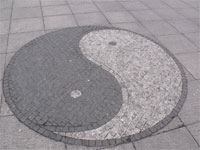 Yin and Yang is a concept that sees opposing forces as interrelated and interconnected in the natural world. These opposing elements and forces give rise to one another and exist in complement to one another, such as light and shadow, male and female, hot and cold, life and death. Yin and Yang is a concept that sees opposing forces as interrelated and interconnected in the natural world. These opposing elements and forces give rise to one another and exist in complement to one another, such as light and shadow, male and female, hot and cold, life and death.
In Taoist belief system, the philosophy of Yin and Yang ties with the idea that everything has both yin and yang elements although one of the element may be more strongly manifested in an object. The belief is that Yin and Yang elements together form a unified whole and are in fact indivisible. In this view of the world, there is no good and bad or dichotomous judgments, but all opposing elements are seen as part of a whole.
Understanding the Taijitu
It is a misconception to understand the Taijitu as conflicting forces of light and dark, good and evil. In fact, the circular symbol of the Taijitu should be understood as a harmonic interaction between opposing forces.
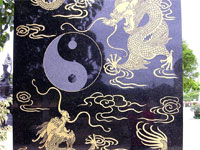 In Taoist belief, both yin and yang elements originate from an initial emptiness, that is referred to as the Wu ji. It is often represented as an empty circle. In Taoist thoughts, from this original emptiness yin and yang arise in equal, opposing, yet interconnected forces. These two forces interact and transform one another in a moving cycle until wu ji is achieved once again. The way to imagine this is to picture the circular symbol of the taijitu in motion, with the swirling black and white halves in constant swirling motion until emptiness is achieved, and from there, yin and yang arises yet again and move in relation to each other until emptiness is once again achieved. In Taoist belief, both yin and yang elements originate from an initial emptiness, that is referred to as the Wu ji. It is often represented as an empty circle. In Taoist thoughts, from this original emptiness yin and yang arise in equal, opposing, yet interconnected forces. These two forces interact and transform one another in a moving cycle until wu ji is achieved once again. The way to imagine this is to picture the circular symbol of the taijitu in motion, with the swirling black and white halves in constant swirling motion until emptiness is achieved, and from there, yin and yang arises yet again and move in relation to each other until emptiness is once again achieved.
The way to understand the relationship between Yin and Yang elements is to see it as when one is at its height, the other is at a low, but once the peak is reached for one, it will then move towards the other quality. An analogy of this is the cyclical nature of seasons. While grains and plants might be in full bloom in summer, it will then move towards death in winter, and a rebirth in spring, in continual cycles of movement and transformation.
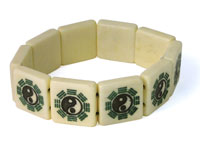 Yang is the white side of the diagram with the black dot, and represents the concept of light, heat, masculinity, fire, daytime, and the sky in Taoist cosmology. The word Yang refers to the sunny side of things. Yin is the black side of the diagram with a white dot, and represents the concept of darkness, coolness, femininity, water, nighttime, and the earth in Taoist cosmology. The word for Yin also refers to the shadowy side of things. Yang is the white side of the diagram with the black dot, and represents the concept of light, heat, masculinity, fire, daytime, and the sky in Taoist cosmology. The word Yang refers to the sunny side of things. Yin is the black side of the diagram with a white dot, and represents the concept of darkness, coolness, femininity, water, nighttime, and the earth in Taoist cosmology. The word for Yin also refers to the shadowy side of things.
Uses of the Concept of Yin and Yang
Beyond its philosophical and cosmological significance in Taoism, the concept of Yin and Yang has been adopted and adapted to various facets in the Chinese culture.
Traditional Chinese Medicine
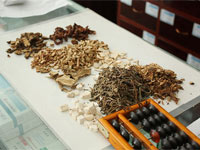 In traditional Chinese Medicine, the concept of a harmonious and balance state of being is central to health and well-being. Traditional Chinese Medicine is founded on the idea that any system that is in harmony is in a good working condition, and the concept is applied to human health. In traditional Chinese Medicine, the concept of a harmonious and balance state of being is central to health and well-being. Traditional Chinese Medicine is founded on the idea that any system that is in harmony is in a good working condition, and the concept is applied to human health.
The two root concepts in traditional Chinese Medicine is “Qi” the concept of vital energy, and the concept of “Yin and Yang”—that of opposing elements.
It is believed that when yin and yang elements are in balance and are harmonious, good health is achieved and maintained. When yin and yang are disharmonious, it is believed that there is too much or too little of one aspect of Qi in relation to another, and this causes illness and pain.
In the traditional Chinese medicine view, because the states of yin and yang are constantly in flux, we must always respond to the changes to ensure that our bodies achieve harmony of yin and yang to maintain a good state of health.
Deficiencies or excesses are both frowned upon in Chinese medicine. This is applied to not only the food that is eaten, but to physical activities, as well as living conditions and mental states. Traditional Chinese medicine promotes moderation and balance. Understanding the concept of yin and yang and using this as a conceptual guideline can help one to achieve harmonious and balance state of being.
Martial Arts
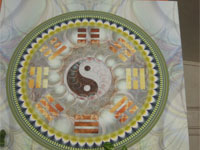 In both qigong and taijiquan, two forms of Chinese martial arts, the concept of yin and yang are crucial for their practices. The Taijiquan, for example, is based on the concept of the taijitu and emphasizes circular motions and is founded on the opposing stances of movements and stillness. It stresses the interconnectedness of not only the person practicing taijiquan, but also his opponent as well his surrounding, so that one’s action should always be in connection and relation to his opponent. In both qigong and taijiquan, two forms of Chinese martial arts, the concept of yin and yang are crucial for their practices. The Taijiquan, for example, is based on the concept of the taijitu and emphasizes circular motions and is founded on the opposing stances of movements and stillness. It stresses the interconnectedness of not only the person practicing taijiquan, but also his opponent as well his surrounding, so that one’s action should always be in connection and relation to his opponent.
Qigong, as its name suggests, is based on the concept of “Qi” vital energy, but the concept of yin and yang also plays an important part in this form of martial art. Qigong primarily deals with breathing patterns and physical movements in practice. The human body is often divided into yin and yang zones in Chinese belief. For example, the upper part of the body is seen as yang and the lower part of the body is seen as yin, while the middle of the body is seen as where the two comes together. Qigong exercises are grouped and viewed in terms of yin and yang and are used to maintain or achieve balances physically.
Significance Today
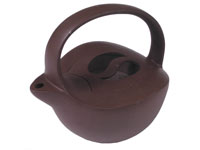 More than just an archaic philosophical view, the concept of yin and yang can still have a lot of practical application for people in the modern world. Its emphasis on the constant state of flux in the natural world and its view that opposing forces are all part of a complementary whole, brings to mind the idea that often our current moral, aesthetic, political, and various views and judgments are merely one way of approaching an issue, and that opposing forces need not conflict or annihilate each other, instead, they may be interconnected and interrelated forces that may in fact both be vital to a larger harmonious whole. More than just an archaic philosophical view, the concept of yin and yang can still have a lot of practical application for people in the modern world. Its emphasis on the constant state of flux in the natural world and its view that opposing forces are all part of a complementary whole, brings to mind the idea that often our current moral, aesthetic, political, and various views and judgments are merely one way of approaching an issue, and that opposing forces need not conflict or annihilate each other, instead, they may be interconnected and interrelated forces that may in fact both be vital to a larger harmonious whole.
|
|
 |
OUR 2013 NEWSLETTERS
The Chinese concept of Yin and Yang
Onsen: Japanese Hot springs—Enjoyment and Etiquette
Lunar New Year 2013: The Year of the Snake
Nabemono - Japanese Hot Pots
NEWSLETTER ARCHIVES
2013
2012
2011
2010
2009
2008
2007
2006
2005
2004
2003
2002
2001
|